In a world where AI is reshaping every industry, the question is no longer if you should adopt it; it’s which type of intelligence will drive the greatest impact for your business.
Today’s enterprise leaders are under pressure to move faster, deliver more with less, and make smarter decisions at scale, all while navigating fragmented data, rising customer expectations, regulatory constraints, and rapidly evolving technologies. In this landscape, knowing what each AI model offers and where it fits is key to staying competitive.
This is the context that ushered in the rise of large language models (LLMs). Built with billions of parameters and trained on massive datasets, LLMs have unlocked a new era of AI capabilities from natural language understanding and generative content to cross-domain reasoning and autonomous workflows. They’ve opened broad possibilities across industries but also surfaced real-world challenges: high costs, latency, governance complexity, and a lack of fine-grained control.
This created both a need and an opportunity for more focused and efficient alternatives.
Enter small language models (SLMs) purpose-built for speed, precision, and domain-specific intelligence. Rather than replacing LLMs, SLMs complement them, excelling in scenarios where low latency, operational simplicity, cost-efficiency, and task-specific accuracy are mission-critical. They meet the growing demand for leaner AI that’s easier to deploy, govern, and scale within enterprise environments.
As the boundaries between LLMs and SLMs blur and their capabilities converge, many organizations find themselves asking:
When should we use which model? Are we sacrificing power for efficiency or gaining a better strategic fit?
This blog breaks it all down, offering a clear comparison between LLMs and SLMs, where each performs best, the trade-offs to consider, and a practical framework to help you choose the right model to align with your enterprise AI strategy.
What are LLMs and SLMs? Core definitions and differences
In the evolving landscape of artificial intelligence, Large language models (LLMs) and Small language models (SLMs) represent two pivotal categories that shape how enterprises harness AI to drive innovation, efficiency, and competitive advantage. Though they share a foundational architecture rooted in transformers, their design philosophies, operational roles, and business implications differ significantly.
Understanding these distinctions is essential for technology leaders seeking to build scalable, resilient, and context-aware AI systems tailored to their organization’s unique demands.
Large language models (LLMs): Generalized, scalable intelligence
Large language models (LLMs) are advanced AI models built to understand, generate, and reason with human language. Trained on massive and diverse datasets including text, code, academic material, and multimodal content, they are designed to perform a broad range of tasks such as summarization, translation, knowledge extraction, and content generation.
With billions to trillions of parameters, LLMs like GPT-4, Claude 3 Opus, and Gemini 1.5 exhibit emergent capabilities such as long-context understanding and few-shot learning, enabling them to adapt quickly to enterprise-specific needs without constant retraining.
Their versatility makes LLMs ideal for powering customer engagement, intelligent automation, knowledge management, and product innovation. Typically deployed via cloud infrastructure, LLM development services provide enterprises with a scalable foundation for AI-driven transformation across business units.
Small language models (SLMs): Task-tuned, operationally efficient AI
Small language models (SLMs) are compact AI models designed to understand and generate human language with speed, efficiency, and precision, all while operating on significantly fewer parameters than large language models (LLMs). Unlike their larger counterparts that require vast computing infrastructure, SLMs are optimized for lightweight deployment across edge devices, internal enterprise systems, and privacy-sensitive environments.
Trained on curated, domain-specific datasets, SLMs deliver high performance on focused tasks such as document summarization, knowledge retrieval, natural language queries, and customer interactions, often with faster response times and lower operational costs. Their smaller footprint enables greater control, improved data governance, and seamless integration into on-prem or hybrid infrastructures.
For enterprises, SLMs provide a practical path to embed AI into daily operations, from automating internal workflows to enhancing decision support without the complexity or risk of large-scale models. Their efficiency, adaptability, and lower resource requirements make them essential components of AI-driven transformation in regulated, real-time, or infrastructure-constrained environments.
Architectural and design differences
Understanding the architectural and design distinctions between Large language models (LLMs) and Small language models (SLMs) is critical for enterprises aiming to optimize AI deployment according to performance, cost, and operational requirements. These differences not only influence model capabilities but also define the practical boundaries of where and how these AI systems deliver value in real-world environments.
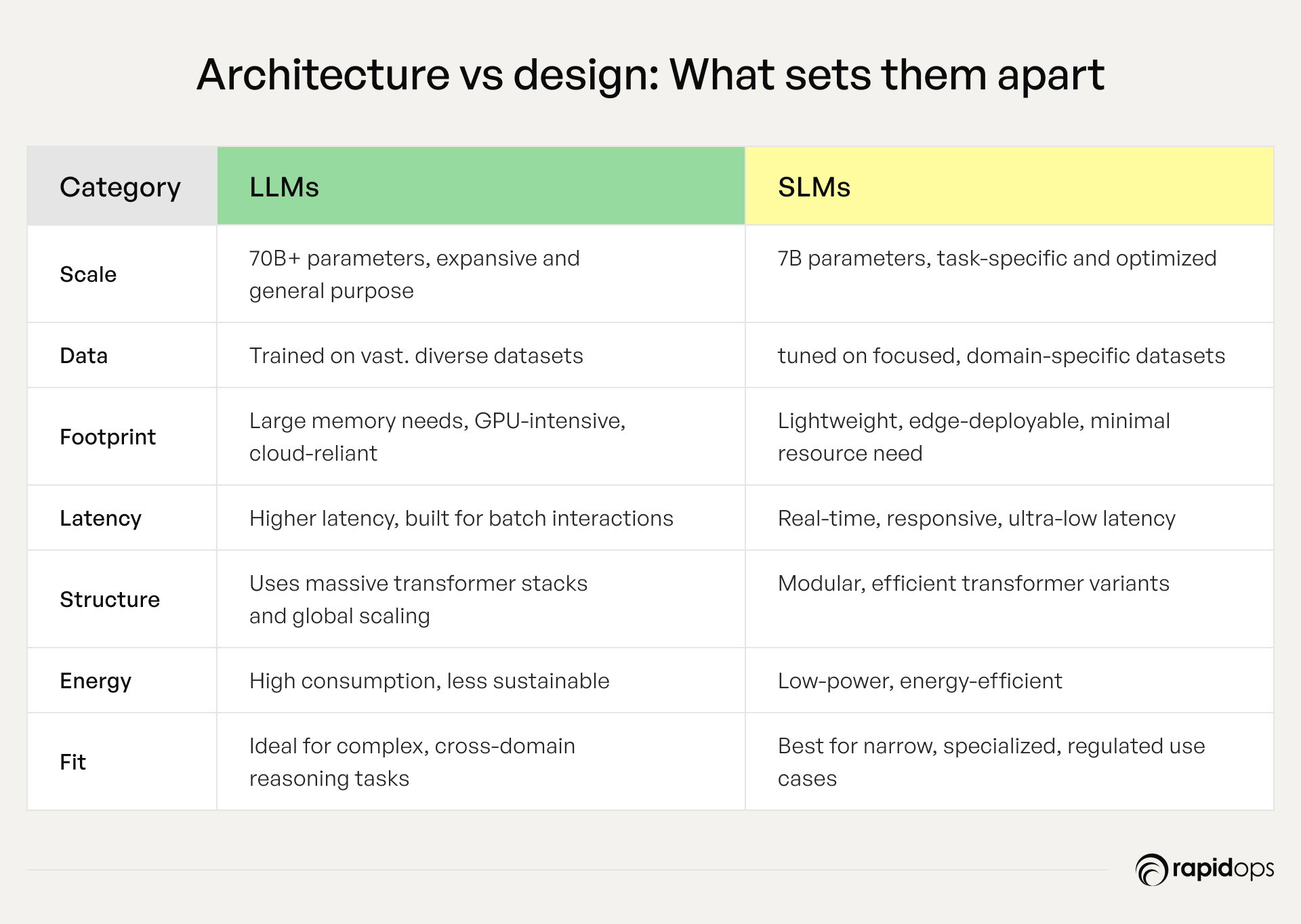
1. Size and parameters: Scale vs specialization
At the core of differentiation lies model size. LLMs typically operate with tens to hundreds of billions of parameters, such as models exceeding 70 billion parameters, enabling expansive knowledge representation and complex reasoning across diverse domains. In contrast, SLMs usually range around 7 billion parameters or fewer, focusing on lean architectures optimized for targeted tasks.
The implications of this disparity are profound: while larger models can generalize across a broad spectrum of applications, smaller models achieve superior efficiency and faster inference by narrowing their scope, allowing enterprises to deploy AI solutions that precisely align with business needs without unnecessary overhead.
2. Training data scope: Broad pretraining vs domain-specific fine-tuning
LLMs undergo extensive pretraining on diverse, large-scale datasets encompassing internet text, scientific publications, codebases, and more, endowing them with general-purpose language understanding. SLMs, however, emphasize domain-specific LLM fine-tuning using proprietary or curated datasets, enhancing their accuracy and relevance within specialized fields such as manufacturing, healthcare, or finance.
This focused training strategy empowers SLMs to excel in high-precision tasks where contextual nuances and regulatory compliance are paramount, while LLMs remain the workhorse for applications demanding wide-ranging, flexible language comprehension.
3. Inference and memory footprint: From cloud-intensive to on-device deployment
The computational demands of LLMs necessitate GPU-intensive infrastructure, often hosted in cloud environments to manage their sizeable memory footprint during inference. Conversely, SLMs are engineered for lightweight compute requirements, enabling deployment on edge devices, embedded systems, or private data centers with limited resources.
This architectural contrast allows SLMs to operate with minimal latency and offline capabilities, crucial for real-time applications where connectivity, privacy, or rapid response times are non-negotiable.
4. Latency and throughput: Real-time responsiveness vs scale
SLMs deliver millisecond-level response times, making them ideal for scenarios requiring instantaneous decision-making, such as autonomous systems or customer service bots. LLMs, while powerful, generally exhibit higher latency due to their complexity and resource needs, which can impact throughput in time-sensitive environments.
Enterprises must therefore balance the trade-off between the expansive cognitive capabilities of LLMs and the operational speed of SLMs, selecting the right model based on workflow criticality and user experience expectations.
5. Model architecture variants: Innovations driving efficiency and capability
Both LLMs and SLMs benefit from continual innovations in transformer architecture, including sparse attention mechanisms, parameter sharing, and modular design. These advancements optimize efficiency, scalability, and adaptability, enabling models to achieve improved performance with reduced computational load.
Such architectural refinements are especially significant for SLMs, where every parameter and operation counts toward maximizing energy efficiency and deployment versatility without sacrificing accuracy.
6. Energy efficiency and sustainability: Environmental impact considerations
In an era of heightened environmental awareness, the energy consumption of AI models is a growing concern. SLMs, with their smaller size and optimized architectures, significantly reduce computational costs and energy usage, supporting sustainable AI practices. LLMs, despite their capabilities, carry a higher carbon footprint due to extensive training and inference requirements.
By strategically incorporating SLMs within AI ecosystems, enterprises can achieve a balance between performance and sustainability, aligning technological innovation with corporate responsibility goals.
These distinctions reveal why LLMs and SLMs aren’t competing; they’re co-creating the future of enterprise AI. When strategically aligned, they allow leaders to balance intelligence with efficiency, scale with control, and innovation with sustainability, unlocking smarter, faster, and more responsible AI systems built for real-world impact.
SLMs vs. LLMs: Key differences shaping enterprise adoption
As AI adoption matures across industries, the decision to implement Small Language Models (SLMs) versus Large Language Models (LLMs) is no longer about model size; it’s about strategic fit. These models serve fundamentally different enterprise goals, environments, and constraints. The following distinctions are reshaping how leading organizations design AI systems for agility, scale, security, and sustainability.
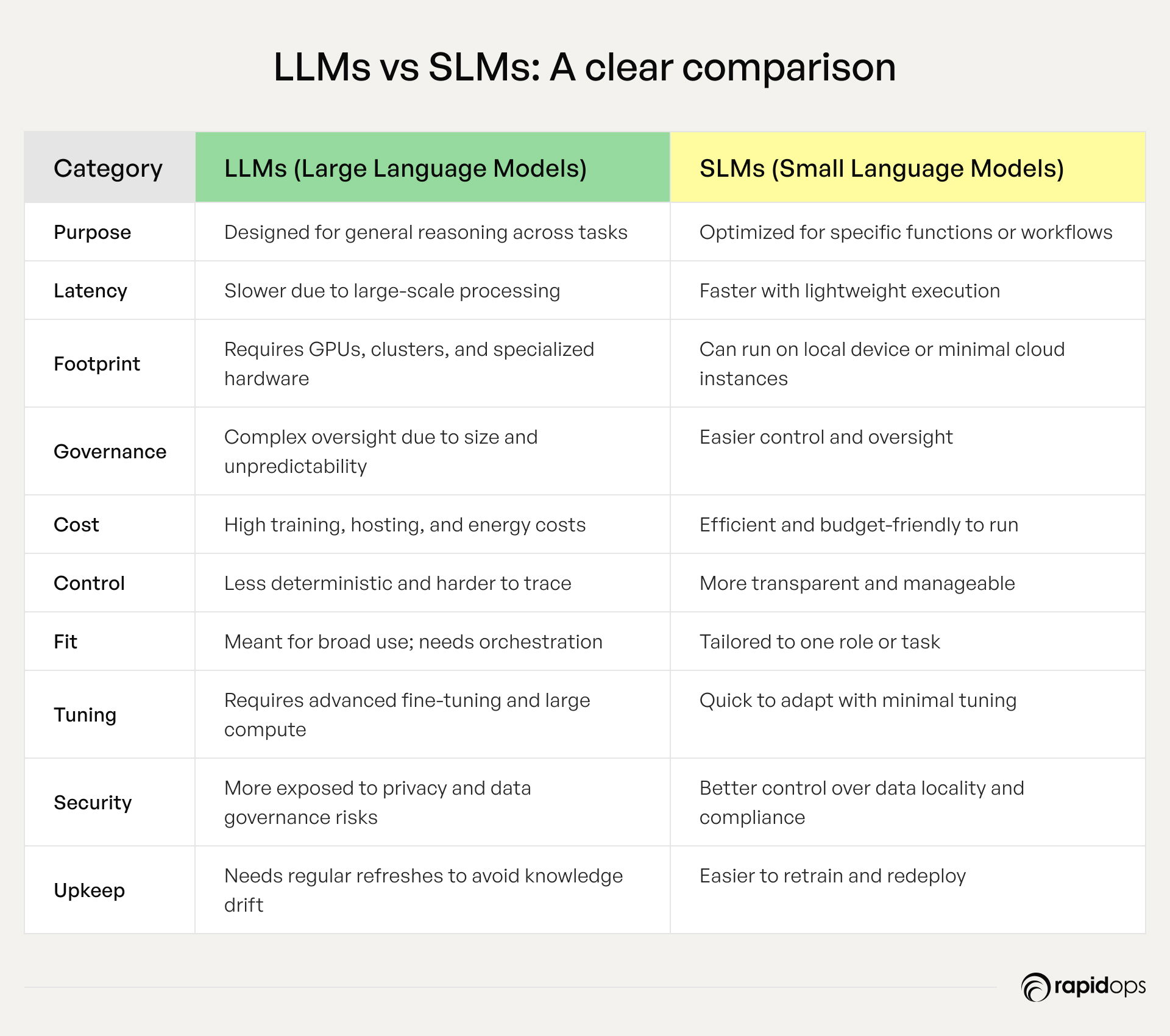
1. Deployment flexibility
SLMs are purpose-built for decentralized AI. Their compact architecture enables deployment on edge devices, mobile platforms, and hybrid infrastructures, bringing intelligence closer to the point of decision. In contrast, LLMs require centralized, high-performance environments typically in the cloud due to their size and processing demands. This divergence defines where and how AI can be embedded across the business.
2. Total cost of ownership (TCO)
SLMs offer a leaner, more sustainable cost structure. Their reduced compute, memory, and power requirements lower infrastructure costs and energy consumption, making them ideal for enterprise-wide rollout. LLMs, while more capable, demand greater investment across training, fine-tuning, and hosting, making them suitable for select, high-impact applications that justify their operational footprint.
3. Fine-tuning efficiency
SLMs can be rapidly fine-tuned using small, domain-specific datasets, enabling teams to deliver value more quickly in regulated or vertical-specific use cases, such as manufacturing, retail, or distribution. LLMs require more time, data, and resources to customize, but provide broader language understanding and contextual depth when deployed strategically.
4. Data privacy and sovereignty
For regulated industries, control over data locality and usage is paramount. SLMs can run fully on-premises or within trusted edge environments supporting compliance with privacy, residency, and security mandates. LLMs, often accessed via cloud APIs, raise concerns around governance, auditability, and jurisdictional control, especially in highly sensitive domains.
5. Inference speed and responsiveness
In latency-critical settings, such as factory floors, logistics hubs, or clinical environments, speed is non-negotiable. SLMs deliver real-time responses due to their lightweight nature and localized deployment. LLMs, although more powerful, can introduce latency due to network hops or heavy processing, making them less ideal for time-sensitive tasks.
6. Scalability and elasticity
LLMs excel in general-purpose deployments, enabling use cases such as enterprise-wide knowledge retrieval and complex document summarization. SLMs, meanwhile, scale horizontally for focused, repeatable tasks such as enabling intelligent automation across thousands of devices or microservices. It’s not a question of scale alone, but rather one of architectural alignment with specific business needs.
7. Latency sensitivity and real-time operations
SLMs are optimized for environments that require always-on, real-time performance even with limited connectivity. This makes them ideal for dynamic pricing, on-site inspection, and last-mile delivery. LLMs may struggle in these contexts unless supported by high-performance, low-latency infrastructure, which comes at a significant cost.
8. Security and control
SLMs provide enterprises with full-stack visibility, from data flow to model behavior, ensuring higher trust and compliance in security-sensitive industries such as defense, banking, or utilities. LLMs, particularly those accessed through third-party services, increase dependency risks and reduce transparency, posing potential vulnerabilities in the AI supply chain.
As generative AI development services transform enterprise operations, the choice between SLMs and LLMs becomes strategic, not a matter of preference. Knowing where each excels empowers leaders to deploy intelligence effectively, drive adaptability, and fuel enterprise transformation aligned with evolving needs and innovation goals.
Where SLMs deliver enterprise value
In an era where speed, efficiency, and governance define enterprise success, Small language models (SLMs) are gaining ground not as scaled-down versions of LLMs but as precision tools purpose-built for business impact. Their real strength lies in delivering agile, secure, and cost-effective intelligence exactly where it’s needed most at the edge, within specific workflows, and across privacy-sensitive domains.
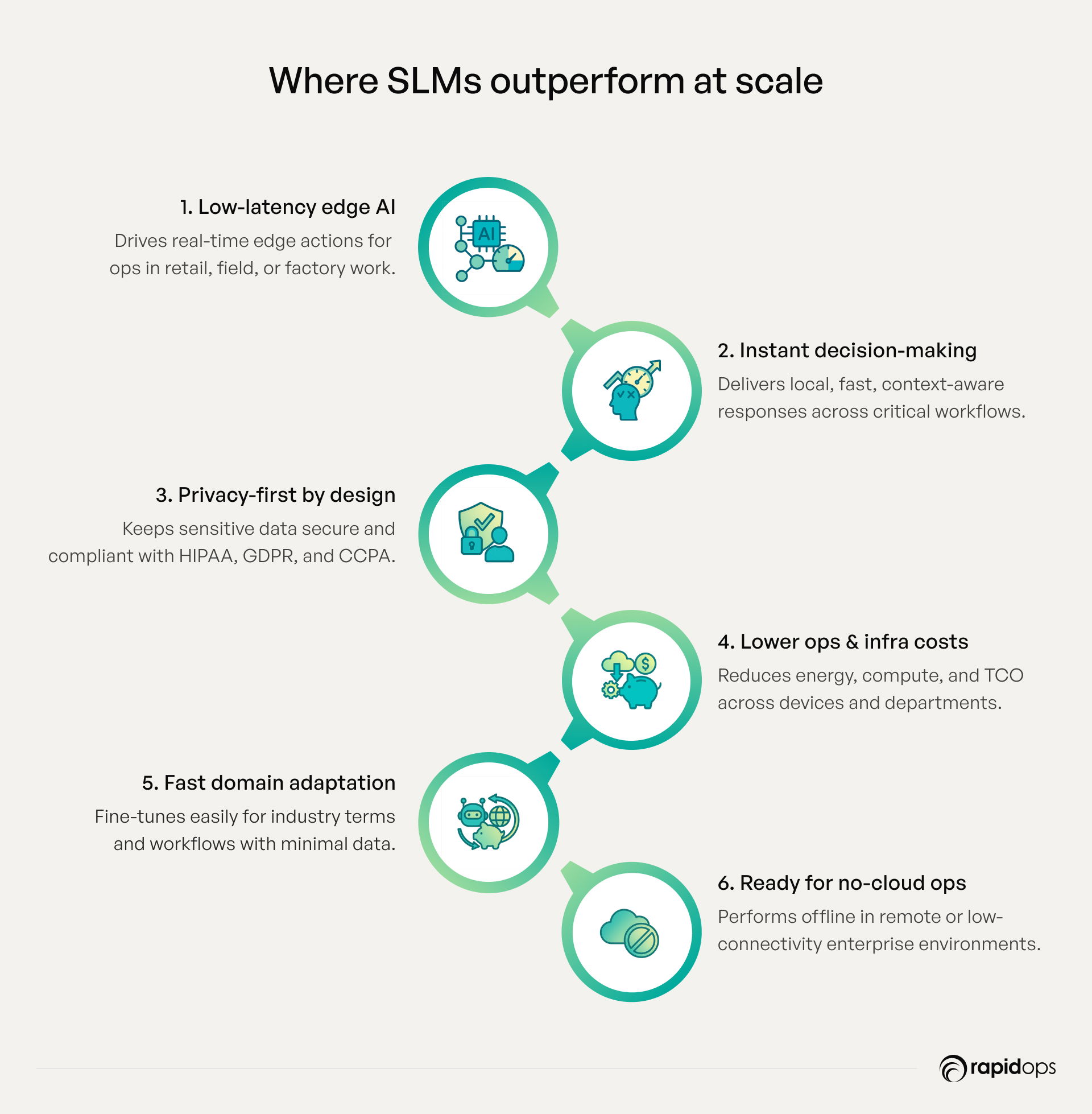
- Low-latency inference at the edge
SLMs are optimized for on-device execution with minimal latency, making them ideal for edge use cases where real-time responses are mission-critical, such as monitoring a production line, assisting field technicians, or enabling smart retail systems.
- Real-time decision support
By processing data locally, SLMs enable immediate, context-aware decisions in dynamic environments such as logistics hubs, factory floors, or patient care settings where milliseconds can significantly impact outcomes.
- Data privacy and compliance by design
SLMs can run securely within enterprise boundaries, allowing organizations to maintain full control over sensitive data while ensuring compliance with industry regulations, such as HIPAA, GDPR, or CCPA.
- Reduced infrastructure and operational costs
Their compact architecture dramatically lowers compute and energy requirements. This not only reduces the total cost of ownership but also supports broader deployment across devices, departments, and constrained environments.
- Domain-specific fine-tuning with minimal resources
SLMs can be quickly fine-tuned using proprietary datasets, thereby accelerating the development of tailored models without the heavy computational requirements associated with LLMs. This makes them highly adaptable to industry-specific vocabularies, workflows, and compliance needs.
- Offline or intermittent connectivity readiness
SLMs function reliably in low-bandwidth or disconnected environments, making them indispensable in remote warehouses, manufacturing plants, or frontline operations where cloud dependence is impractical.
Where LLMs offer more power
Large language models (LLMs) are uniquely positioned to unlock enterprise-scale intelligence that spans departments, domains, and decisions. Their capabilities extend beyond narrow task execution to enable broad, high-impact reasoning across complex systems.
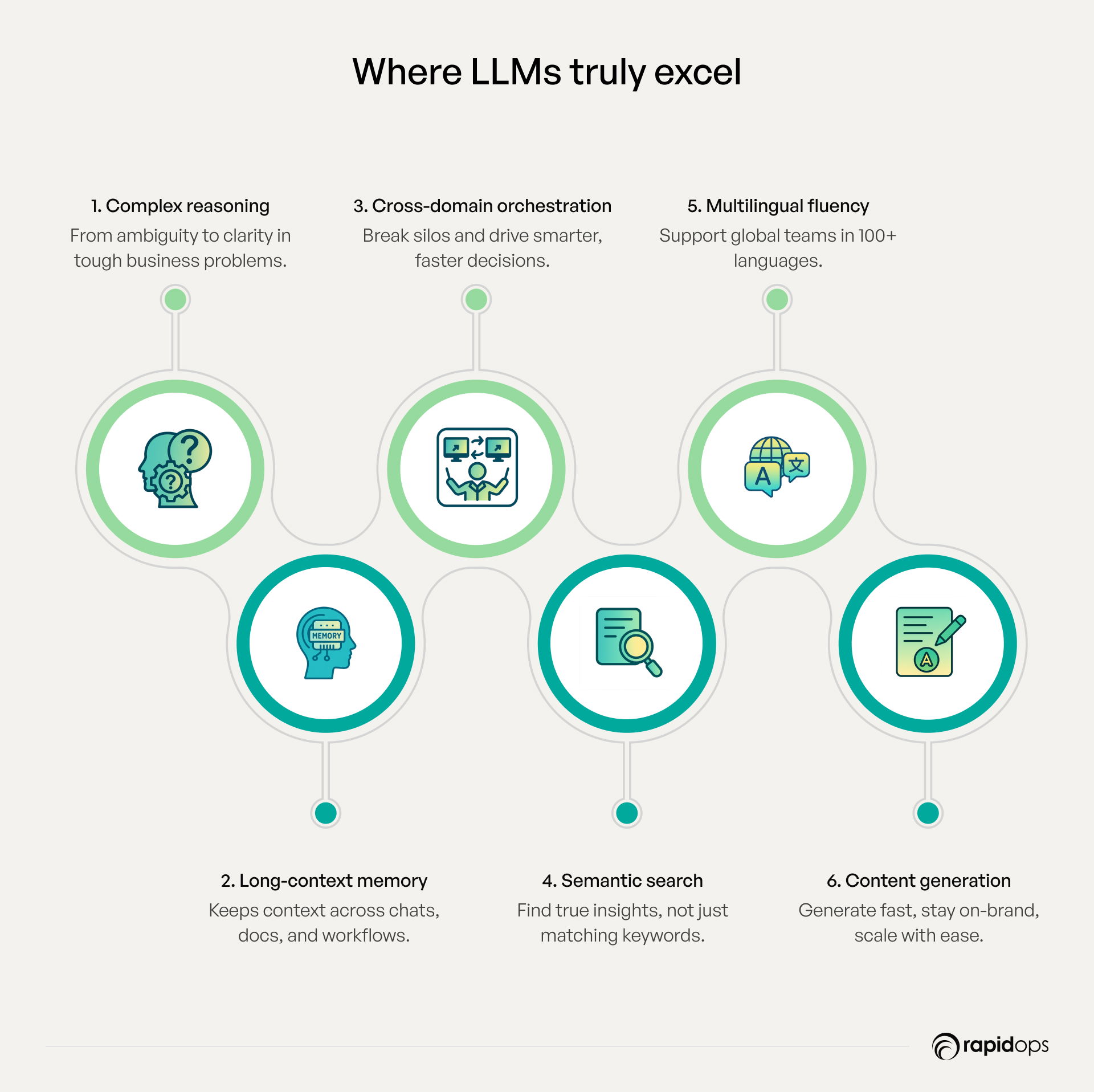
- Complex reasoning and open-ended generation
LLMs excel at synthesizing incomplete or ambiguous inputs into meaningful outputs, enabling enterprises to solve complex business problems, create dynamic content, and support innovation at scale.
- Multi-turn, long-context understanding
Unlike simpler models, LLMs maintain context across extended conversations or document streams, making them ideal for AI copilots, customer support, and cross-functional workflow orchestration.
- Enterprise-wide orchestration and cross-domain intelligence
LLMs break data silos by interpreting structured and unstructured inputs from different departments, enabling cohesive insights, system interoperability, and intelligent automation across the enterprise.
- Advanced semantic search across vast unstructured data
With deep language understanding, LLMs go beyond keyword search to retrieve meaning-rich answers from complex documentation accelerating decision-making in R&D, legal, operations, and compliance.
- Multilingual understanding and translation
LLMs empower global operations with built-in language capabilities, enabling seamless internal collaboration, content localization, and customer engagement across geographies.
- Automated content generation and augmentation
From generating product descriptions to summarizing reports or augmenting knowledge bases, LLMs boost productivity across marketing, HR, legal, and customer service functions while preserving brand, tone, and compliance.
Understanding the limits of SLMs and LLMs
As enterprises evaluate where and how to deploy language models, it’s equally important to understand the architectural trade-offs. Both small and large language models come with constraints that directly impact enterprise scalability, deployment decisions, and return on AI investments. A nuanced understanding of these limitations enables smarter orchestration between model types based on context, criticality, and compute availability.
Limitations of small language models (SLMs)
Understanding the limitations of small language models (SLMs) is key to using them effectively, it helps identify where they shine and where larger models may add value.
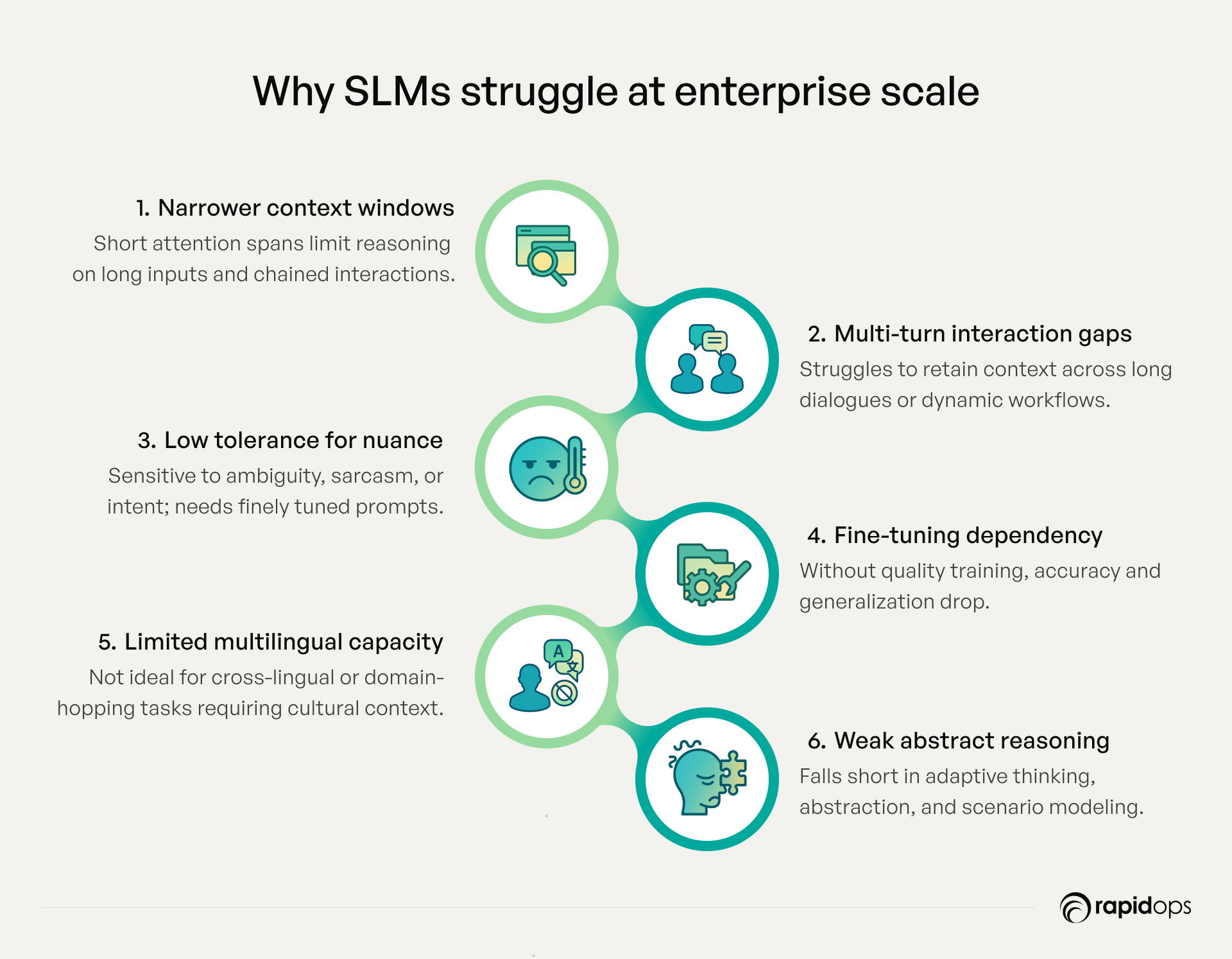
1. Narrower context windows
SLMs operate within shorter attention spans, limiting their ability to reason across long documents, complex workflows, or chained user interactions.
2. Challenges with multi-turn interactions
While efficient at single-task execution, SLMs can falter in maintaining context over extended, multi-turn conversations or dynamic dialogues, affecting continuity and coherence.
3. Sensitivity to ambiguity and nuance
SLMs may struggle with domain-specific ambiguity, sarcasm, or subtle intent variations, requiring finely tuned prompts and training data to perform reliably.
4. Fine-tuning dependency
Their performance hinges on high-quality, task-specific fine-tuning. Without this, generalizability and accuracy can drop sharply, especially in edge cases.
5. Limited multilingual and cross-domain capacity
Unlike LLMs, SLMs are typically optimized for a narrower linguistic and functional scope making them less suited for use cases requiring translation, cultural nuance, or domain-hopping intelligence.
6. Constrained abstraction and dynamic reasoning
SLMs may underperform in abstract reasoning, scenario modeling, or evolving queries where adaptability and high-level generalization are critical.
Limitations of large language models (LLMs)
While large language models (LLMs) offer powerful capabilities in reasoning and language generation, understanding their limitations is essential to balance performance with cost, speed, and practical enterprise fit.
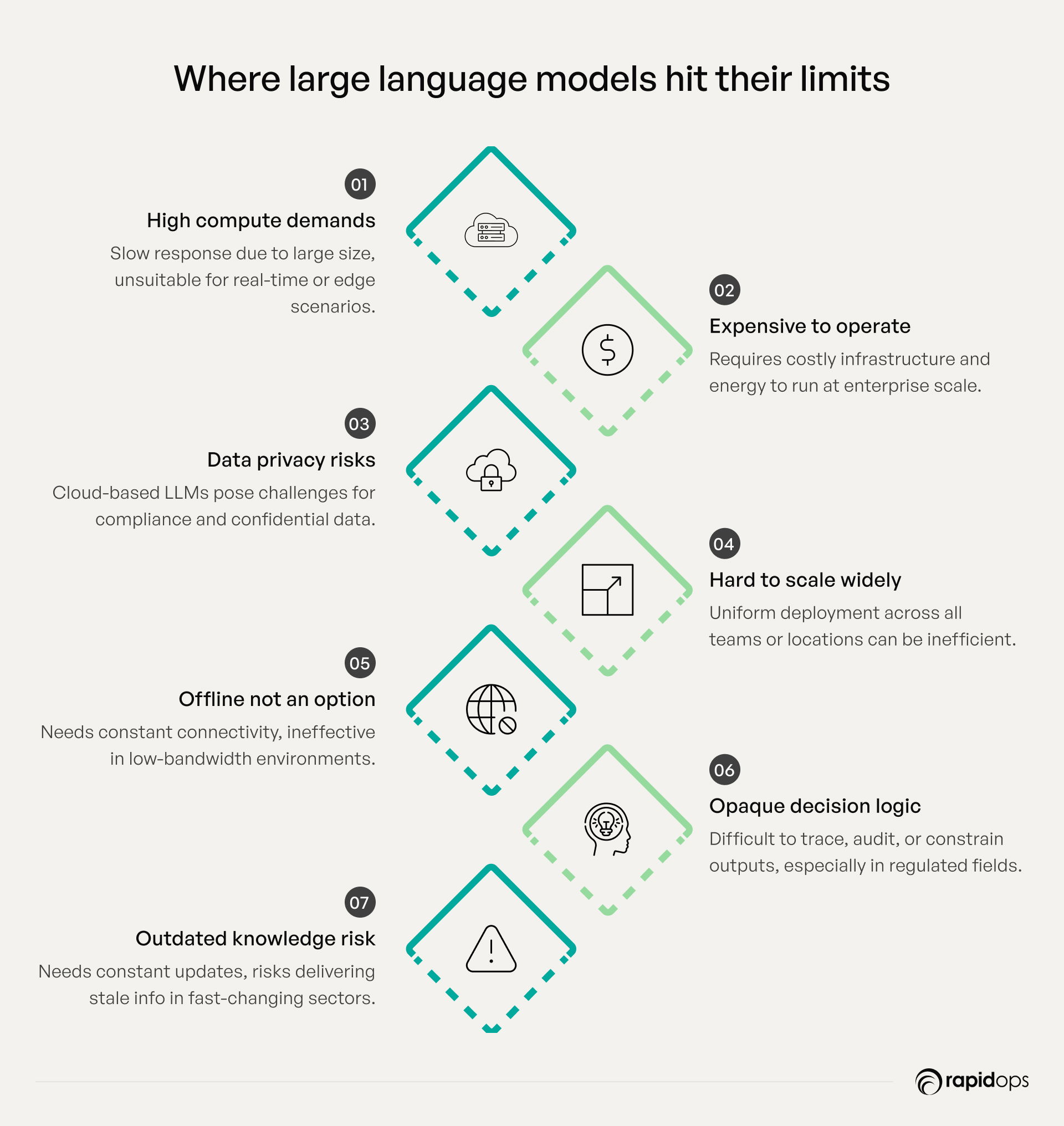
1. Higher latency and inference overhead
LLMs demand significant compute power, resulting in slower response times an obstacle in real-time, edge, or time-sensitive decision environments.
2. Operational and infrastructure cost
Running LLMs at scale requires substantial cloud infrastructure, GPUs, and energy escalating both upfront and ongoing operational expenditures.
3. Risks with sensitive data handling
Most LLMs operate in cloud-based environments, posing challenges around data residency, confidentiality, and compliance with privacy regulations.
4. Scalability bottlenecks
Deploying LLMs uniformly across enterprise applications, departments, or locations can be cost-prohibitive and technically complex.
5. Inefficiency in offline and edge environments
Due to their size and compute requirements, LLMs are impractical in settings with limited bandwidth or intermittent connectivity.
6. Explainability and controllability gaps
LLMs often function as opaque systems, making it harder to audit decisions, enforce constraints, or trace model behavior, especially in regulated industries.
7. Knowledge staleness
Without continuous retraining or real-time grounding, LLMs risk delivering outdated information, especially in fast-evolving domains like healthcare, finance, or compliance.
Recognizing the limits of SLMs and LLMs is not a compromise it’s a strategic advantage. When enterprises map these constraints to real-world needs, they unlock more precise, efficient, and scalable AI systems. Success comes not from choosing the biggest model, but from deploying the right one, in the right place, for the right task.
SLM vs LLM: Choosing the right model for the right task
In an enterprise AI strategy, model selection isn’t just a technical decision; it’s a strategic one. Small language models (SLMs) and large language models (LLMs) each bring distinct advantages, but their value is unlocked only when deployed with precision. Choosing the right model means aligning capabilities to context, matching the nature of the task, the operational environment, and broader business goals.
When to use SLMs
SLMs are purpose-built for scenarios where lightweight deployment, real-time responsiveness, offline readiness, and strict on-device data control are critical to business operations.
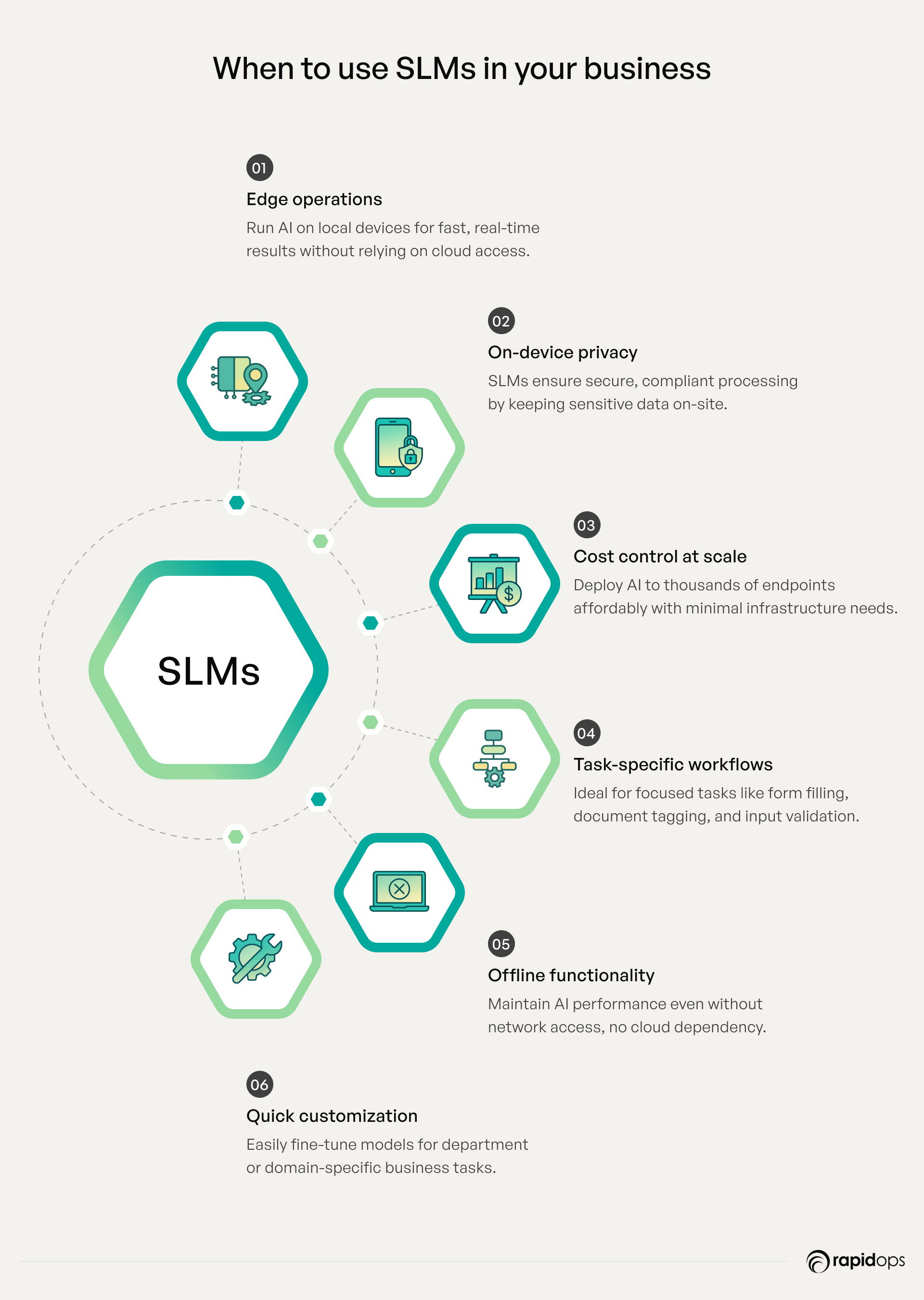
- Edge-centric operations: From factory floors to retail checkout systems, SLMs deliver low-latency performance without relying on the cloud, which is critical for real-time responsiveness.
- On-device privacy and compliance: In highly regulated environments, SLMs enable secure, on-prem inference, minimizing data movement and enhancing control.
- Cost-effective scalability: Enterprises deploying AI across thousands of endpoints or departmental tools can rely on SLMs to keep costs manageable while maintaining performance.
- Task-specific workflows: When the task is repetitive, focused, and narrow, such as automating form completion or validating structured inputs, SLMs outperform by staying lightweight and efficient.
- Offline-ready capabilities: SLMs are ideal for environments with limited or unreliable connectivity, ensuring operational continuity without compromising intelligence.
- Targeted customization: With fewer parameters, SLMs are easier and faster to fine-tune for specific roles or domain-specific applications within a business unit.
When to use LLMs
LLMs are best suited for complex, knowledge-rich, and cross-functional scenarios that demand deep reasoning, long-context understanding, and broad generalization across diverse domains and data types.
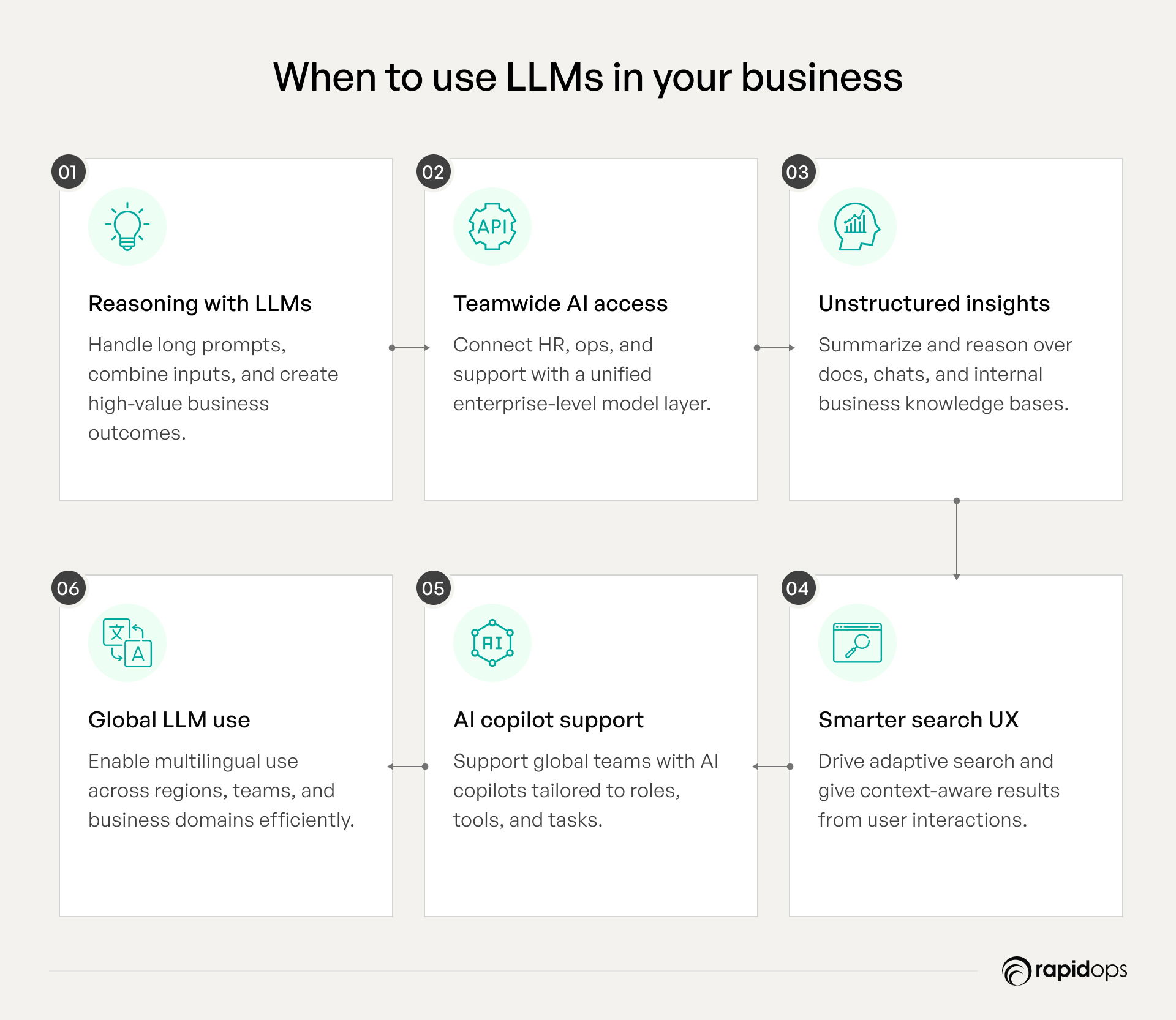
- Complex reasoning and open-ended tasks: For workflows involving long-context understanding, synthesis of unstructured inputs, or creative ideation, LLMs deliver unmatched performance.
- Enterprise-wide applicability: When multiple departments like customer service, supply chain, and HR share a unified intelligence layer, LLMs act as a foundational platform.
- Unstructured data intelligence: From surfacing insights in enterprise knowledge bases to automating document summarization, LLMs offer the scale and comprehension needed to navigate vast, diverse data.
- Advanced search and personalization: LLMs power semantic retrieval, intelligent recommendations, and contextual assistance that adapts to user behavior in real time.
- Cross-functional digital assistants: For copilots supporting enterprise users across roles and regions, LLMs enable adaptive, natural, multi-turn conversations.
- Multilingual, multi-domain support: In global enterprises, LLMs facilitate seamless interaction across languages, domains, and departments, bridging silos through unified intelligence.
The decision between SLMs and LLMs isn’t binary; it’s architectural. The most forward-looking enterprises design hybrid AI ecosystems, deploying the right model in the right place, while orchestrating them through intelligent model routing, privacy-aware design, and business-aligned AI governance. This layered approach enables scalability, precision, and trust across the enterprise.
SLM, LLM, or Hybrid? Find the model that it's your enterprise
Now that you understand the fundamental differences between Small Language Models and Large Language Models, the real decision isn’t about size, it’s about strategic fit. The best model for your enterprise is the one that aligns with your unique goals, data infrastructure, and operational realities.
LLMs excel at deep reasoning, generating broad content, and handling complex, multi-domain tasks. Meanwhile, SLMs deliver speed, efficiency, enhanced privacy, and on-device performance, making them ideal for focused, sensitive, or latency-critical applications. Success comes from deploying the right model, at the right place, for the right purpose.
At Rapidops, we move beyond experimentation to practical AI adoption. We assess your AI maturity, identify whether an SLM, LLM, or hybrid approach best suits your business, and then build, fine-tune, and deploy solutions designed to create a measurable impact.
Whether your priority is streamlining operations, empowering smarter decisions, or transforming customer experiences, our team is here to ensure your AI investments deliver real, scalable value.
Not sure which model fits your needs?
Book a free strategy session with one of our language model experts. We’ll start by understanding your business, processes, and goals. From there, we recommend the right language model approach and supporting tech stack, then provide a tailored, actionable strategy to help you implement it quickly and effectively.
Frequently Asked Questions
Why are small language models becoming important in 2025?
Small language models (SLMs) are gaining momentum in 2025 due to their high utility and lower computational overhead. As businesses prioritize AI cost efficiency, control, and compliance, SLMs enable on-device intelligence, faster inference, and easier fine-tuning for domain-specific tasks, especially where large-scale cloud inference isn’t viable or necessary.
Do SLMs use transformer architecture like LLMs?
Yes, most small language models are based on the same transformer architecture as LLMs. The key difference lies in the number of parameters, depth of layers, and computational requirements. SLMs retain core architectural strengths such as attention mechanisms and contextual embeddings while operating within a lighter, faster footprint.
Are small language models easier to train and deploy than LLMs?
Absolutely. SLMs are easier to train, fine-tune, and deploy due to their smaller size and lower infrastructure demands. Enterprises can host them on local servers, edge devices, or secure environments, enabling faster iteration cycles, cost-effective experimentation, and better control over model behavior and data governance.
How do SLMs support multilingual or code-mixed environments?
Modern SLMs can be trained or fine-tuned to handle multilingual or code-mixed input effectively. While they may not match LLMs in language breadth, focused fine-tuning on regional or industry-specific datasets allows SLMs to excel in specialized multilingual contexts like localized customer support or field operations across diverse regions.
What is the future of small language models in enterprise AI?
SLMs will play a critical role in the enterprise AI stack, especially in edge AI, embedded systems, and private environments. Their ability to deliver fast, task-specific intelligence at lower cost and risk makes them ideal for decentralized workflows, personalized interfaces, and domain-aware co-pilots, complementing LLMs rather than replacing them.
Can SLMs be integrated into existing enterprise software stacks?
Yes. SLMs can be seamlessly embedded into CRMs, ERPs, and analytics platforms using lightweight APIs or containerized services. This allows enterprises to enhance internal tools with context-aware automation, like suggesting product insights in sales tools or extracting insights from structured reports in finance systems without relying on external cloud LLMs.
Can I use an SLM for real-time decision-making at the edge?
Yes, SLMs are ideal for edge environments where real-time processing, low latency, and data privacy are critical. For instance, in manufacturing, logistics, or IoT setups, SLMs can enable intelligent decision-making directly on devices without sending data to the cloud, ensuring speed, resilience, and compliance with regulatory constraints.

Rahul Chaudhary
Content Writer
With 5 years of experience in AI, software, and digital transformation, I’m passionate about making complex concepts easy to understand and apply. I create content that speaks to business leaders, offering practical, data-driven solutions that help you tackle real challenges and make informed decisions that drive growth.
What’s Inside
- What are LLMs and SLMs? Core definitions and differences
- Architectural and design differences
- SLMs vs. LLMs: Key differences shaping enterprise adoption
- Where SLMs deliver enterprise value
- Where LLMs offer more power
- Understanding the limits of SLMs and LLMs
- SLM vs LLM: Choosing the right model for the right task
- SLM, LLM, or Hybrid? Find the model that it's your enterprise

Let’s build the next big thing!
Share your ideas and vision with us to explore your digital opportunities
Similar Stories
- AI
- 4 Mins
- September 2022

- AI
- 9 Mins
- January 2023


Receive articles like this in your mailbox
Sign up to get weekly insights & inspiration in your inbox.

